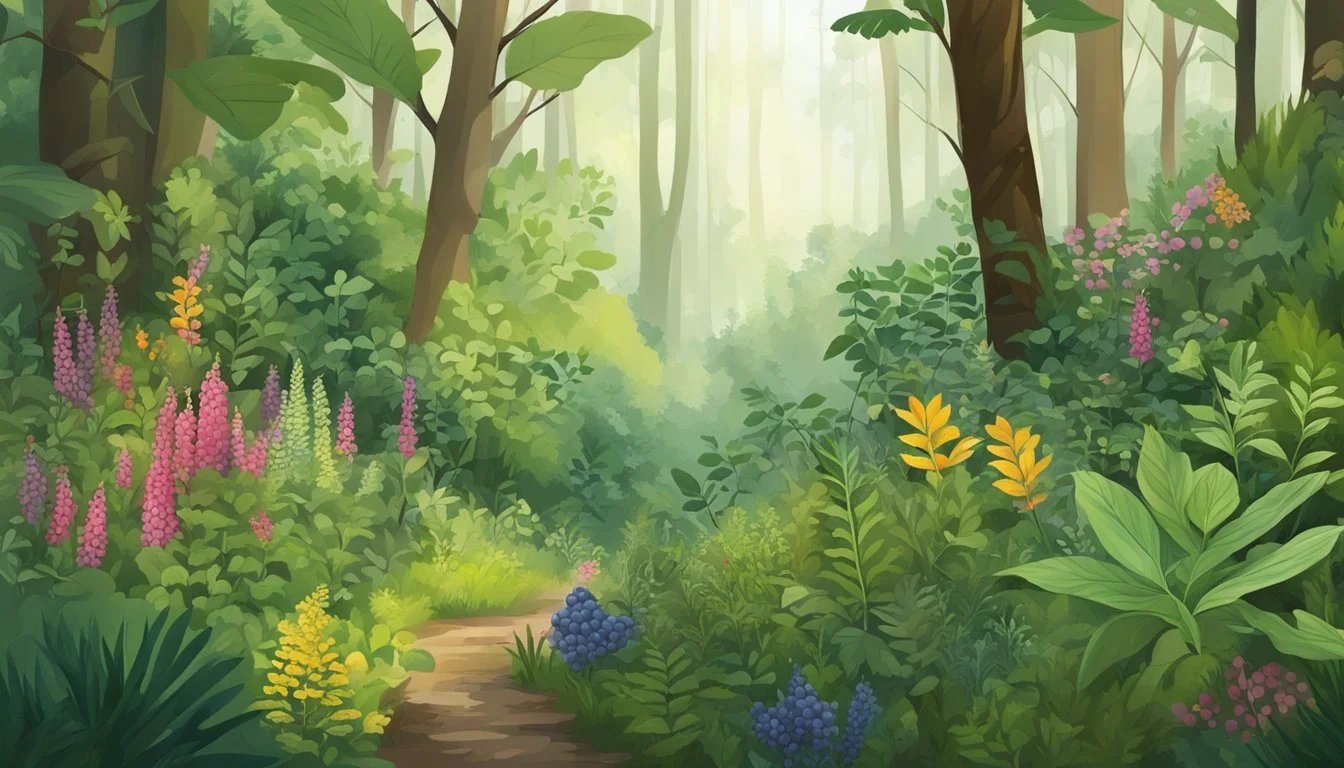Finger Lakes Native Edible Plants
A Guide to Local Foraging
The Finger Lakes region is a treasure trove of native edible plants, offering a unique blend of biodiversity and top-tier conservation efforts. This area, supported by organizations like the Finger Lakes Native Plant Society (FLNPS), is home to plants that not only thrive in the wild but also provide nutritional value. Knowing where to find these plants and how to sustainably harvest them can greatly enhance one's connection to nature and commitment to conservation.
Native species such as Campanula rotundifolia, often known as harebells, thrive in the region and, with their prolific seeding, can be easily propagated by local gardeners. Meanwhile, the skunk cabbage, another native plant, adds an interesting culinary twist with its edible qualities. Ethical practices in foraging and planting are emphasized by FLNPS, ensuring that these natural resources are preserved for future generations.
Regular FLNPS meetings and educational programs further promote the importance of these native plants. By attending these gatherings, both novice and experienced botanists can gain valuable insights into the roles native plants play in maintaining ecological balance. Conservation efforts are paramount, with a focus on protecting these plants from invasive species and development pressures.
Understanding Native Plants
Native plants in the Finger Lakes region offer ecological, aesthetic, and practical benefits. Conserving these plants ensures the health of local ecosystems and supports sustainable harvesting practices for future generations.
Definition and Significance
Native plants are species that have naturally occurred in a region for centuries. In the Finger Lakes, these plants are well-adapted to the local environment and climate.
Their significance lies in their ability to thrive without requiring extensive maintenance. They also provide critical habitats and food sources for indigenous wildlife.
By reducing the need for chemical fertilizers and pesticides, native plants contribute to a healthier environment and sustainable agricultural practices.
The Role in Ecosystems
Native plants play a crucial role in maintaining the balance and health of ecosystems. They offer habitats for a variety of insects, birds, and mammals.
These plants also aid in soil stabilization, preventing erosion and promoting water retention. Their deep-root systems improve soil health and increase biodiversity within the ecosystem.
In contrast, invasive plants can disrupt these balances, outcompeting native species and leading to a decline in local wildlife and plant diversity.
Conservation Efforts
Conserving native plants involves protecting them from threats such as habitat destruction, invasive species, and climate change. Organizations like the Finger Lakes Native Plant Society focus on education and advocacy.
Activities include tracking and managing invasive species, promoting the use of native plants in landscaping, and supporting restoration projects.
By fostering community awareness and participation, these efforts ensure that native plants continue to play their vital roles in local ecosystems and remain a resource for sustainable harvest.
Participation in local seed exchanges and utilizing resources from groups like the Cornell Cooperative Extension can further bolster these conservation efforts.
Regional Ecosystems and Habitats
The Finger Lakes region boasts diverse ecosystems that support a wide variety of native edible plants. Each habitat type presents unique growing conditions, influencing which plants thrive there.
Meadows and Grasslands
Meadows and grasslands in the Finger Lakes are abundant with sunlight-loving plants. Species here often have deep root systems to survive dry spells and competition for nutrients. Common native edibles include wild strawberries (Fragaria virginiana) and milkweed (Asclepias syriaca).
These areas support a variety of wildlife, including pollinators like bees and butterflies. Milkweed, for instance, is crucial for the monarch butterfly lifecycle. Seasonally, meadows are peppered with edible flowers and herbs, prized for their medicinal properties and culinary uses.
Wetlands and Floodplains
Wetlands and floodplains are characterized by saturated soil conditions, making them home to water-tolerant plants. Edible plants such as cattails (Typha latifolia) and wild rice (Zizania aquatica) are prominent in these areas.
Cattails are highly versatile, offering edible shoots, roots, and pollen. Wetlands also provide important breeding grounds for amphibians and waterfowl, creating a dynamic ecosystem. The spicebush (Lindera benzoin), a shrub found in these habitats, produces berries and branches that can be used for tea and cooking spices.
Forest And Shaded Areas
Forest areas, particularly those with dense canopy coverage, support shade-loving plants. Among these, ramps (Allium tricoccum) and blackberries (Rubus allegheniensis) are well-known. Forest habitats in the Finger Lakes often have rich soil, contributing to the diversity of edible plants.
Ramps are a spring delicacy, cherished for their garlicky flavor. The layered canopy structure also supports mushrooms like chanterelles and morels. These ecosystems provide critical shelter and resources for many bird species and mammals, maintaining biodiversity.
By understanding the specific ecosystems and habitats in the Finger Lakes, one can better appreciate the variety of native edible plants and their ecological roles.
Seasonal Cycles and Plant Growth
Native edible plants in the Finger Lakes region experience distinct seasonal cycles that affect their growth and availability. These cycles include spring emergence, summer maturation, fall preparation and seed dispersal, and winter dormancy, each contributing to the plant's life cycle and seasonal behaviors.
Spring Emergence
As temperatures rise in March, native edible plants begin to emerge. Early sprouting species include dandelion greens and Claytonia virginica, known for their nutritious young leaves. These plants respond to increased daylight and warmer soil, pushing through the ground to form new growth.
Moisture from spring rains supports this early growth. Foragers often seek these tender, nutrient-rich greens during this time. Spring also sees morel mushrooms and wild leeks appearing, adding to the variety of forageable edibles available.
Summer Maturation
By summer, many native plants have fully matured. Wild blueberries, for example, are abundant, providing vitamins and antioxidants. Other species, such as the oak and hemlock forests outlined in local guides, thrive in moist conditions, offering edible resources like nuts and berries.
This season is crucial for photosynthesis and energy storage. Longer days and warmer weather facilitate the rapid growth and development of these plants. Gardeners and foragers alike benefit from the bounty of mature plants, which are at their peak nutrient content.
Fall Preparation and Seed Dispersal
As fall approaches, plants begin to prepare for the cold months. Trees like the sycamore and cottonwood drop their seeds, ensuring the next generation. This period, from September to November, is marked by the ripening of nuts and berries.
These edible seeds and fruits are vital food sources for wildlife and humans. For example, the chestnut-flavored corms of Claytonia virginica are harvested during this time. Seed dispersal mechanisms, including wind and animal movement, ensure the propagation of these plants.
Winter Dormancy
Winter brings dormancy, with plants reducing metabolic activities to survive the cold months of December and beyond. Deciduous trees shed leaves, and herbaceous plants die back to their root systems, conserving energy.
This dormant phase is essential for plant survival, allowing internal repairs and energy storage. Snow cover often provides insulation, protecting roots from freezing temperatures. Although above-ground growth halts, many plants continue important underground activities, preparing for the next cycle of growth.
Cultivation and Gardening
Cultivating native edible plants in the Finger Lakes region requires selecting species that adapt well to local conditions, properly maintaining them, and employing effective propagation methods. It's crucial to adhere to ethical guidelines to protect local ecosystems.
Selecting Native Plants
Choosing the right native plants is foundational for a thriving garden. Harebells (Campanula rotundifolia), American cranberry, and other native species are recommended due to their adaptability. Using a plant finder tool can assist in identifying suitable species for varied conditions such as dry uplands or moist bogs.
Focus on plants that can tolerate local soil, climate, and water availability. For example, American cranberry thrives in consistently moist, acidic soil, suiting the cooler climates of the Finger Lakes.
Planting and Maintenance
Proper planting techniques involve ensuring that the selected species have the necessary root environment. For instance, American cranberry requires soil with a pH between 4.0 and 5.2. Ensure consistent moisture to support healthy growth.
Use mulch to retain soil moisture and reduce weeds. Regularly check the plants for signs of pests or diseases. Harebells prefer rocky or stony sunlit areas, so selecting the perfect spot is essential.
Propagation Techniques
Propagation enhances the sustainability of native plant gardens. Utilize seed exchanges or local seed collections. Many native plants, like Harebells, are prolific seed producers.
Use techniques such as layering, division, and seed propagation to expand your plantings. American cranberry can be propagated by layering, where branches in contact with soil develop roots.
Ethical Considerations
While cultivating native plants, it's vital to respect local ecosystems. Avoid over-harvesting from wild populations; instead, focus on growing your own plants from seeds or cuttings. Use locally-sourced seeds to maintain genetic diversity and ecosystem stability.
Ensure that your gardening practices do not contribute to the spread of invasive species. Promote biodiversity by planting a variety of native species that support local wildlife.
Plant Profiles and Characteristics
In the Finger Lakes region, there is a diverse range of native edible plants. These plants can be classified into several categories based on their nature and growth habits, such as trees and shrubs, herbaceous plants, and grasses and ferns.
Trees and Shrubs
The trees and shrubs native to the Finger Lakes are often sought for their edible fruits and nuts. Acer rubrum (red maple) and Acer saccharinum (silver maple) both offer sap that can be boiled to produce maple syrup. Amelanchier laevis (smooth serviceberry) produces sweet berries in early summer.
Cornus alternifolia (pagoda dogwood) bears small, edible berries that are high in antioxidants. Corylus americana (American hazelnut) produces nuts that are a source of protein and healthy fats. Most of these plants are adaptable to various soil types and conditions, making them excellent choices for naturalizing and restoration projects.
Herbaceous Plants
Herbaceous plants, which die back to the ground each year, include a variety of species found in the Finger Lakes. Allium tricoccum (ramps) are highly valued for their onion-like flavor and leaves that appear early in spring. Campanula rotundifolia (harebells) flourish in rocky, sunny habitats and produce prolific seeds.
Asarum canadense (wild ginger) provides edible roots that can be used as a spice. Solidago (goldenrods) are not just beautiful but also attract beneficial insects. Several herbaceous plants also have medicinal properties, like Echinacea purpurea (purple coneflower), used traditionally to boost immune function.
Grasses and Ferns
Grasses and ferns are less commonly noted for their edibility but hold important roles in the ecosystem. Sporobolus heterolepis (prairie dropseed) is a perennial grass that provides seeds consumed by birds and can be turned into a fine flour. Several fern species, such as Matteuccia struthiopteris (ostrich fern), produce edible fiddleheads in spring.
Panicum virgatum (switchgrass) is another native grass that stabilizes soil and serves as wildlife fodder. Ferns like Dryopteris species flourish in shaded, moist environments and are crucial for maintaining forest floor health. Grasses and ferns often propagate through spores, adding diversity to their reproductive strategies.
Noteworthy Native Species
Exploring the Finger Lakes region reveals a rich tapestry of edible plants such as Spicebush, Shadbush, Trout-Lilies, Dutchman's Breeches, Wild Columbine, and Bee Balm. Each plant offers unique flavors and uses that add to the region's biodiversity and culinary possibilities.
Spicebush and Shadbush
Spicebush (Lindera benzoin) stands out with its aromatic leaves, twigs, and berries. The berries, which turn red in autumn, can be dried and used as a spice similar to allspice. Native Americans and early settlers used Spicebush tea for medicinal purposes, and its twigs are still used for making tea today.
Shadbush (Amelanchier spp.), also known as Serviceberry or Juneberry, produces small, sweet, and edible berries that ripen in early summer. These berries are rich in antioxidants and can be used in pies, jams, and other culinary creations. The tree's early spring blossoms are also an important food source for pollinators, adding ecological value to its edible benefits.
Trout-Lilies and Dutchman's Breeches
Trout-Lilies (Erythronium americanum) are delicate spring ephemerals with mottled leaves and bright yellow flowers. While not commonly harvested for food, the young leaves were traditionally consumed by Native Americans. Care should be taken as they contain low levels of toxins and should only be eaten in moderation.
Dutchman's Breeches (Dicentra cucullaria) feature unique, pantaloon-shaped flowers and are another spring ephemeral. Although not edible, they play a vital role in the ecosystem. These plants thrive in rich, woodland soil and contribute to the forest's health by supporting early pollinators.
Wild Columbine and Bee Balm
Wild Columbine (Aquilegia canadensis) is known for its striking red and yellow flowers. While the plant itself is not typically consumed, it has historical significance as Native American tribes used its seeds for medicinal purposes. The flowers attract hummingbirds, making it a valuable addition to gardens for natural pest control.
Bee Balm (Monarda didyma), also called Oswego tea, is a member of the mint family. Its vibrant red flowers and fragrant leaves can be used to make a flavorful tea. This plant is rich in thymol, an essential oil with antiseptic properties. Additionally, Bee Balm is a favorite among bees and butterflies, fostering a healthy garden ecosystem.
Native Plants and Wildlife
Native plants in the Finger Lakes region support a diverse array of wildlife. From insects to birds and mammals, these plants are integral to sustaining local ecosystems.
Pollinators and Plant-Pollinator Relationships
The Finger Lakes' native plants play a crucial role in pollination. Native bees, particularly digger bees like Andrena and Lasioglossum, are essential pollinators for these plants. These bees rely on the pollen and nectar provided by native flora.
Butterflies, including the West Virginia White Butterfly, also rely on specific plants for nectar. These pollinator-plant relationships ensure the survival of both the insects and the plants. Effective pollination increases plant reproduction and biodiversity in these ecosystems.
Host Plants for Butterfly and Moth Species
Certain native plants serve as crucial host plants for butterflies and moth species. For example, the larvae of the West Virginia White Butterfly feed on plants such as toothwort. Without these specific host plants, the butterfly species cannot complete their life cycle.
Many moth species, including the Luna Moth, depend on a variety of native trees such as hickory and walnut for their larvae. Planting and conserving these host plants helps maintain the populations of these butterflies and moths, ensuring their continued presence in the Finger Lakes region.
Food Sources for Birds and Mammals
Native plants provide vital food sources for birds and mammals in the Finger Lakes. Native berries, seeds, and nuts sustain birds like the American Robin and Mammals such as squirrels. Birds often feed on the fruits of plants like the American cranberry, which thrive in moist, acidic soils.
Additionally, the seeds produced by flowering native plants attract small mammals. These relationships help sustain wildlife and contribute to the ecological balance. Deer and other large herbivores also rely on these native plants for sustenance, highlighting the importance of preserving these native species.
Ecological Threats and Challenges
The native edible plants of the Finger Lakes face several ecological threats and challenges that jeopardize their sustainability and survival. These challenges include the proliferation of invasive non-native species, habitat loss and fragmentation, and the impacts of climate change on local flora.
Invasive Non-Native Species
Invasive non-native species present a significant threat to the native plant diversity in the Finger Lakes region. These aggressive plants often outcompete local flora for resources like sunlight, water, and nutrients. Species such as Garlic Mustard (Alliaria petiolata) and Japanese Knotweed (Fallopia japonica) can dominate large areas, reducing the habitat for native edible plants.
The rapid spread of these non-native plants often leads to a decline in native vegetation, disrupting ecosystems. Eradicating or controlling invasive species is costly and labor-intensive, further complicating conservation efforts in the region.
Habitat Loss and Fragmentation
Habitat loss and fragmentation significantly impact native plants in the Finger Lakes. Urbanization, agricultural development, and infrastructure projects reduce the available natural habitats for these plants. This leads to smaller, isolated populations that are more vulnerable to local extirpation.
Fragmented habitats disrupt plant-pollinator interactions, seed dispersal mechanisms, and genetic exchange between plant populations. Sustaining native edible plant species requires preserving large, contiguous areas of natural habitat and creating wildlife corridors that connect fragmented landscapes.
Climate Change Impact on Flora
Climate change poses an evolving challenge to the survival of native edible plants. Altered temperature and precipitation patterns can disrupt the growth cycles, flowering times, and distribution of these plants. Harsher winters and more frequent droughts can stress sensitive species, reducing their resilience.
Changes in climate conditions can also alter the composition of plant communities, favoring more adaptable species over those less tolerant to new conditions. Efforts to mitigate climate change and adapt to its impacts are crucial in preserving the diverse native flora of the Finger Lakes.
Community and Education
Education and community involvement play a vital role in promoting and preserving native edible plants in the Finger Lakes region. Numerous organizations and initiatives focus on increasing awareness and engagement through various programs and activities.
Native Plant Societies and Groups
The Finger Lakes Native Plant Society (FLNPS) is a key player in the area. They host talks, walks, and activities aimed at both experts and beginners interested in the conservation and appreciation of native plants. The society addresses threats like invasive species, providing valuable insight and practical advice.
Educational Programs and Workshops
The FLNPS offers robust educational programs and workshops that cover a range of topics, from plant identification to conservation techniques. Indoor programs and field trips are organized to provide hands-on learning experiences. Initiatives like the "Virtual Winter Wild Edible Plant Walk" highlight the diversity of educational efforts available.
Public Garden Involvement
Public gardens in the Finger Lakes region, often supported by community efforts and native plant societies, provide valuable educational resources. These gardens not only display native plants but also serve as interactive educational spaces. They offer opportunities for the public to engage in gardening activities and learn about sustainable practices through direct involvement.
Conservation and Ethical Practices
In the Finger Lakes region, the focus on conservation and ethical practices helps ensure the sustainability of native edible plants. Emphasis is placed on sustainable harvesting methods, legal considerations, seed exchange programs, and the preservation of biodiversity.
Sustainable Harvesting and Legalities
Sustainable harvesting ensures that native plant populations remain robust. Harvesting should not exceed 10% of the available plants to allow natural regeneration. Legal status varies; some plants may be protected by local, state, or federal laws.
Foragers must be aware of the population status of the plants they collect. Overharvesting can lead to endangerment. Informing the community about ethical foraging practices preserves native plants for future generations.
Seed Exchange Programs
Seed exchange programs play a vital role in conservation efforts. They allow gardeners and conservationists to share seeds from native plants, ensuring genetic diversity. FLNPS and similar organizations often facilitate these exchanges.
Participants learn about proper seed collection and storage techniques, promoting the propagation of native flora. This contributes to the long-term preservation of native species and their adaptability to changing environments.
Preserving Biodiversity
Biodiversity preservation is crucial for ecosystem health. Native plants support local wildlife and contribute to ecological balance. Initiatives aimed at preserving biodiversity focus on protecting habitats and restoring degraded areas.
Maintaining a diverse plant community helps buffer against environmental changes. Educating the public on the importance of biodiversity ensures community support for conservation efforts. Protecting a wide range of species guarantees that ecosystems remain resilient and functional.











